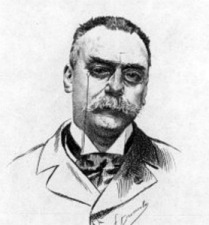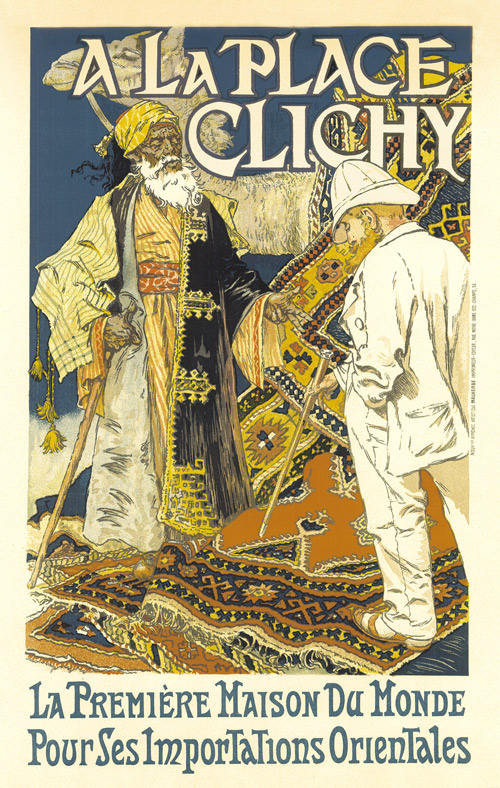Place Clichy - 1892
VINTAGE FRENCH POSTER - GICLÉE PRINT
This vintage French poster is an example of "Affiche
Artistique",
advertising Eastern
imports titled A la Place Clichy. The artist was Eugene
Grasset and the poster was published in 1892.
Dimensions: 15.25" x 24"
|
Item# |
Title |
Choose: |
Shp Wt |
Price |
Click to buy |
|
1W-ART-112-1 |
Place Clichy, 1892 |
Archival Paper |
2 lbs. |
$29.95 |
Add to Basket |
|
1W-ART-112-5 |
Place Clichy, 1892 |
Repositionable Peel & Stick Fabric* |
2 lbs. |
$39.95 |
Add to Basket |
|
*Peel & Stick: Repositionable
self-adhesive fabric that resists water, wrinkles and tears.
Can be repositioned with ease without damaging walls. No
need for screws, tape or push-pins, simply peel and stick. |
Artists in the late 1800s found
opportunities to present their work to the masses through advertising art
that began to appear as billboards and posters, plastering the streets of
Paris. “Affiche Artistique” was the term that the French used to describe a
poster that contained artistic expression. The art was so impressive
to the public, people began to collect the posters as soon as they went up,
which is why they are so scarce today. Artists such as Henri
Toulouse-Lautrec, Alphonse Mucha, Jules Chéret, Théophile-Alexandre
Steinlen, Pierre Bonnard and Eugène Grasset contributed to the creative body
of work that became what some called “a free museum for the masses”.
The craze for collecting these examples of modern art was even given the
name, "affichomanie", meaning “artistic poster mania”. Collectors today pay
hundreds, if not thousands for original prints of these rare posters.
We offer these exceptional vintage poster reproductions in
the highest possible print quality. Superior to most reproductions
currently available on the market, our gallery quality prints are suitable
for display in an art gallery or museum. We begin with an ultra high
resolution scan of the original artifact which we leave untouched, leaving
intact the slightly distressed vintage character desirable in a collectible
piece of this era. Our state of the art, giclée reproduction process
uses the latest technology: microscopic droplets of ink that render such a
high resolution, that every minute detail of the original is intact.
Every pen line and brush stroke is visible. Even very faint pencil
lines are also visible due to the incredibly high quality of the
reproduction process. Our 8 color, archival quality inks and giclée
printing process provide the most accurate color reproduction & are proven
to last over a hundred years. Posters are available printed on museum
quality archival paper or on repositionable media that allow you to plaster
your walls with the “Affiche Artistique”, just as they were originally
intended to be displayed.
About the artist:
Eugène Grasset
Swiss, 1845-1917
Born in Lausanne, Switzerland into a
family of skilled artisans, Eugène Grasset studied drawing under Swiss
artist and teacher
 Francois-Louis
David while still in Lausanne, then traveled to Zurich where he studied
architecture. Grasset visited Egypt after completing his education, an
experience that would influence his later work. Francois-Louis
David while still in Lausanne, then traveled to Zurich where he studied
architecture. Grasset visited Egypt after completing his education, an
experience that would influence his later work.
Grasset moved to Paris in 1871 and
worked as a designer of textiles, ceramics and jewelry, creating decorative
pieces that were to become the standard of Art Nouveau motifs. He
discovered commercial opportunities in graphic design, producing postage
stamps for France and Switzerland and logo-art that was used by several
publishers. His poster art, however, was most successful, becoming so
popular that several American companies commissioned him to design posters.
Grassets' work in America introduced Art Nouveau to the American public,
which soon dominated American art.
Eugène Grasset began a teaching
career in Paris that was to influence generations of studens, beginning at
the École Guérin (1890-1903), and including the École d’Art graphique
(1903-1904), the Académie de la Grande Chaumière (1904-1913) and the École
Estienne. The “Grasset” typeface was introduced at the Universal
Exhibition of 1900 in Paris, created by Eugène Grasset in 1898.
Eugène Grasset died in Sceaux,
southwest of Paris, in 1917. His art continues to be considered the
cornerstone of Art Nouveau style.
Sarah Bernhardt
French, (1844 -1923)
Rosine Bernardt, the woman who was to
be introduced as “the most famous actress the world has ever known” began
life as the illegitimate child of Jewish mother Julie Bernardt, who worked
as a courtesan in Paris. Sarah Bernhardt added the “H” to her last
name and took the name Sarah as her stage name, beginning her acting career
in 1862 while a student at Comédie Française. She traveled to Belgium
where she became the mistress of Henri, Prince de Ligne. Sarah gave
birth to the prince’s son, Maurice, in 1864. Although the prince
wanted to marry her, his family was against the union and convinced Sarah to
end their relationship.
.jpg) Bernhardt
began performing at the Théâtre de L’Odéon in 1866. In 1870, when the
Franco-Prussian war began, Sarah is credited with converting the theatre
into a makeshift hospital and taking care of wounded soldiers there.
Throughout the 1870’s Bernhardt’s success climbed. She traveled all
over Europe and even to Cuba, where she performed in Matanzas’ Sauto Theater
in 1887. Bernhardt
began performing at the Théâtre de L’Odéon in 1866. In 1870, when the
Franco-Prussian war began, Sarah is credited with converting the theatre
into a makeshift hospital and taking care of wounded soldiers there.
Throughout the 1870’s Bernhardt’s success climbed. She traveled all
over Europe and even to Cuba, where she performed in Matanzas’ Sauto Theater
in 1887.
In 1899, Sarah Bernhardt opened the
Théâtre Sarah-Bernhardt on the Place du Châtelet in Paris. She earned
the title “The Divine Sarah” following the premiere of her performance in
the title role of “Hamlet”. The play was four hours long and received
rave reviews.
Bernhardt continued to act and
produce plays until her death in 1923. She starred in eight motion
pictures including the film of 1912, “Sarah Bernhadt á Belle-Isle”, a film
about her daily life. Her theatre’s name was changed to “Théâtre de la
Cité” by the Germans in World War II, because of her Jewish ancestry.
|
 |